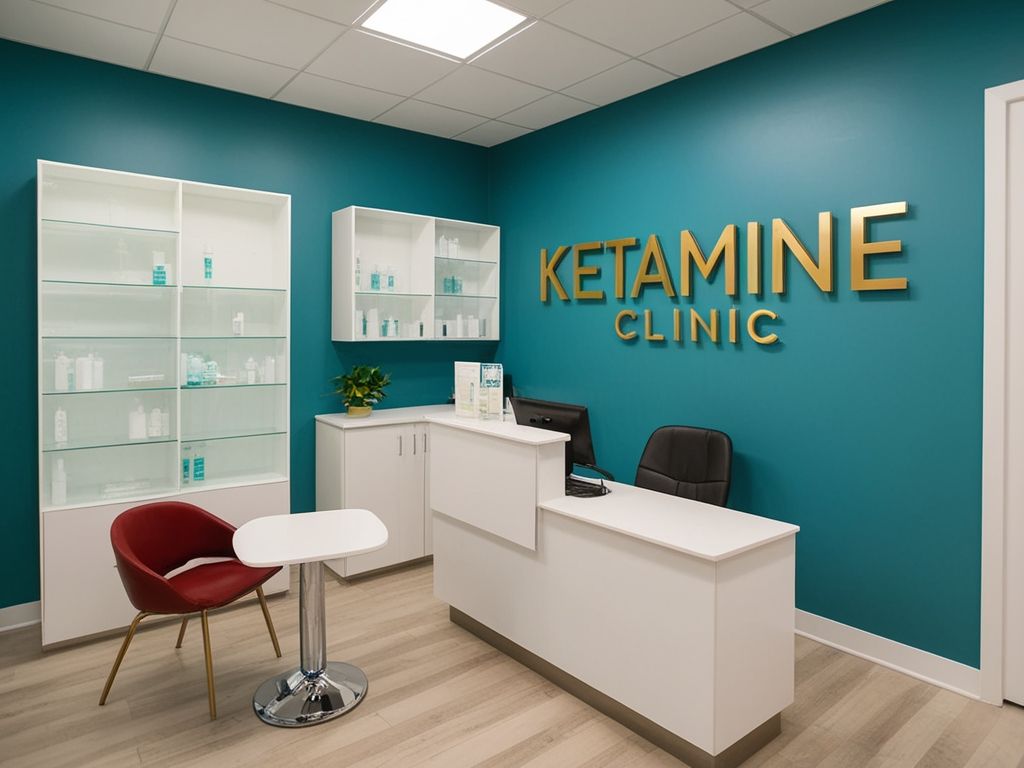
The ketamine therapy market has gone from obscure to commonplace, with the U.S. ketamine-clinic market valued at $3.4 billion in 2023, up 70% from 2018, and is projected to grow nearly 11% annually through 2030, according to Grand View Research. As mental health awareness continues to rise and alternative treatments gain acceptance, ketamine clinics face remarkable opportunities, along with growing competitive forces and significant marketing challenges in reaching potential patients.
Patient Acquisition Takes More Than Just Infrastructure
The ketamine therapy industry isn’t like Kevin Costner’s flick “Field of Dreams.” Success in this specialized healthcare sector requires more than just opening doors and waiting for patients to come. These statistics underscore the critical importance of effective digital marketing strategies for clinic growth and sustainability.

Understanding and avoiding common marketing pitfalls becomes increasingly vital for ketamine clinic operators and ketamine practitioners looking into 2025 and beyond. The healthcare digital marketing landscape has evolved significantly, with medical practices that implement comprehensive digital marketing strategies seeing an average 49% increase in patient acquisition year-over-year.
This digital revolution in healthcare marketing isn’t just a trend; it’s becoming the defining factor between thriving ketamine clinics and those struggling to maintain market relevance. As the ketamine therapy sector continues its exponential growth, with the market expected to reach new heights, the stakes for effective marketing have never been higher.
The Ketamine Clinic Marketing Imperative
Ketamine clinics that fail to implement a robust digital marketing strategy face a significant risk of declining revenues. This reality is driven by three critical factors reshaping the industry.
Digital Transformation
First, the digital transformation has fundamentally changed how patients research and select healthcare providers, making online presence and engagement essential for practice success.
Healthcare consumers are increasingly beginning their treatment journey online, marking a significant shift in how patients approach their medical care. Mobile health searches have grown by over 100% in the past two years, demonstrating the undeniable movement toward digital health information access. Patient education and engagement are predominantly happening in digital spaces, creating new opportunities and challenges for healthcare providers to connect with and inform their potential patients.
Competitive Landscape
Second, the ketamine industry’s competitive landscape has become increasingly crowded, with new clinics entering the market at an unprecedented rate and traditional mental health providers expanding their services to include ketamine therapy.
The ketamine therapy market is experiencing rapid growth and evolution, with new clinics entering the market at an unprecedented rate. Traditional mental health providers are expanding their services to include ketamine therapy, recognizing its potential in treating various mental health conditions. Meanwhile, telehealth platforms are revolutionizing patient acquisition strategies, making it easier for patients to access care while creating new competitive challenges for established providers.
Market Evolution
Finally, market evolution plays a crucial role, as growing public awareness of alternative mental health treatments and rising demand for personalized patient experiences necessitate a strong digital presence to effectively communicate value propositions and attract patients.
The mental health treatment landscape is undergoing a remarkable transformation, with growing public awareness of alternative mental health treatments leading the way. There is an increasing acceptance of psychedelic therapy in mainstream healthcare, as both medical professionals and patients recognize its potential benefits. Additionally, there is a rising demand for personalized patient experiences, with individuals seeking treatment options that are tailored to their specific needs and preferences.
Passive Response Could Lead to Painful Outcomes
In today’s burgeoning ketamine therapy market, a passive approach to business growth through digital marketing can result in significant negative consequences. Declining market share becomes an immediate concern as more proactive competitors capture available opportunities and establish stronger positions within the ketamine industry. This decline often begins gradually but can accelerate rapidly if left unaddressed.
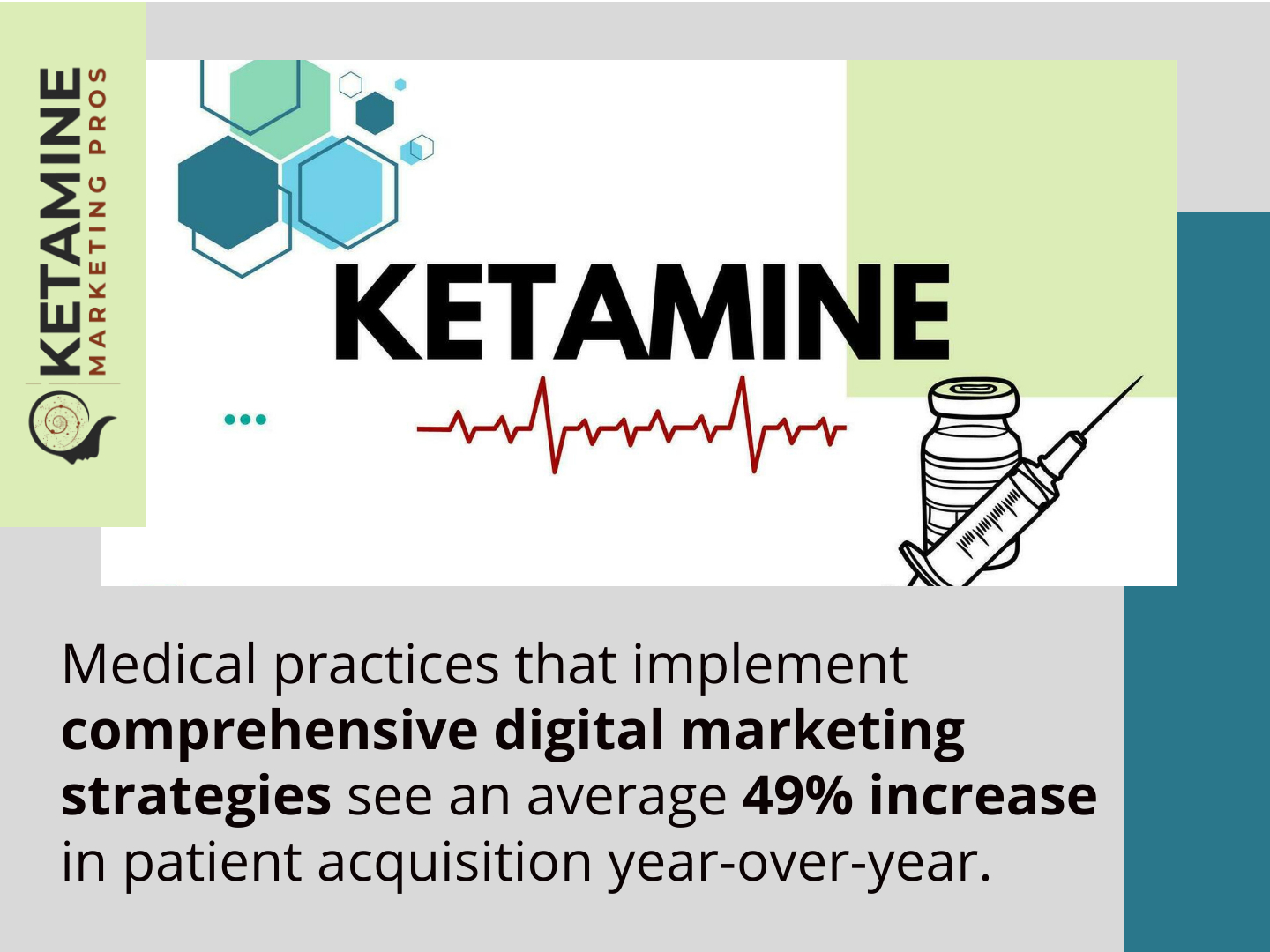
The impact on patient acquisition can be particularly severe, as potential ketamine therapy patients increasingly choose providers who demonstrate innovation and active engagement in meeting their needs. Reduced patient flow not only affects immediate operations but can create long-term challenges in maintaining practice viability. This directly translates into decreased revenue streams, affecting everything from operational capabilities to investment in new technologies and services.
Limited ketamine clinic brand visibility becomes another critical issue, as practices that fail to actively promote their services and engage with their community fade from public awareness. This reduced presence in the market makes it increasingly difficult to attract new patients and retain existing ones. Finally, a diminished competitive advantage emerges as more aggressive competitors implement new technologies, expand their service offerings, and adapt to changing patient preferences, leaving passive ketamine therapy practices struggling to maintain their position in the market.
5 Key Marketing Missteps That Can Derail Your Ketamine Clinic
In this critical analysis, we’ll examine five fundamental marketing mistakes that ketamine clinics must actively avoid to maintain their competitive edge and ensure sustainable growth in an increasingly saturated market. These insights are essential for:
- Established clinics looking to protect and expand their market position
- New practices aiming to establish a strong market presence
- Healthcare providers considering entering the ketamine therapy space
- Clinic operators seeking to optimize their marketing ROI
Understanding and addressing these common pitfalls isn’t just about survival – it’s about positioning your clinic for sustained success in an industry that continues to expand and evolve at a remarkable pace. As we delve into each mistake, we’ll provide actionable strategies and solutions that can be implemented immediately to enhance your clinic’s market presence and patient acquisition efforts.
The following analysis will serve as your roadmap to avoiding critical marketing missteps while building a robust, future-proof marketing strategy that drives sustainable growth in the dynamic ketamine therapy landscape of 2025 and beyond.
Mistake Number One: Neglecting Content Creation for Ketamine Therapy
Content marketing has proven to be one of the most cost-effective marketing strategies, generating three times as many leads as traditional outbound marketing while costing 62% less. Across the board, organizations that prioritize blogging receive 97% more links to their websites and generate 67% more leads per month. The substantial improvement in these key performance indicators demonstrates the powerful impact of sustained content marketing efforts on business growth and market visibility.
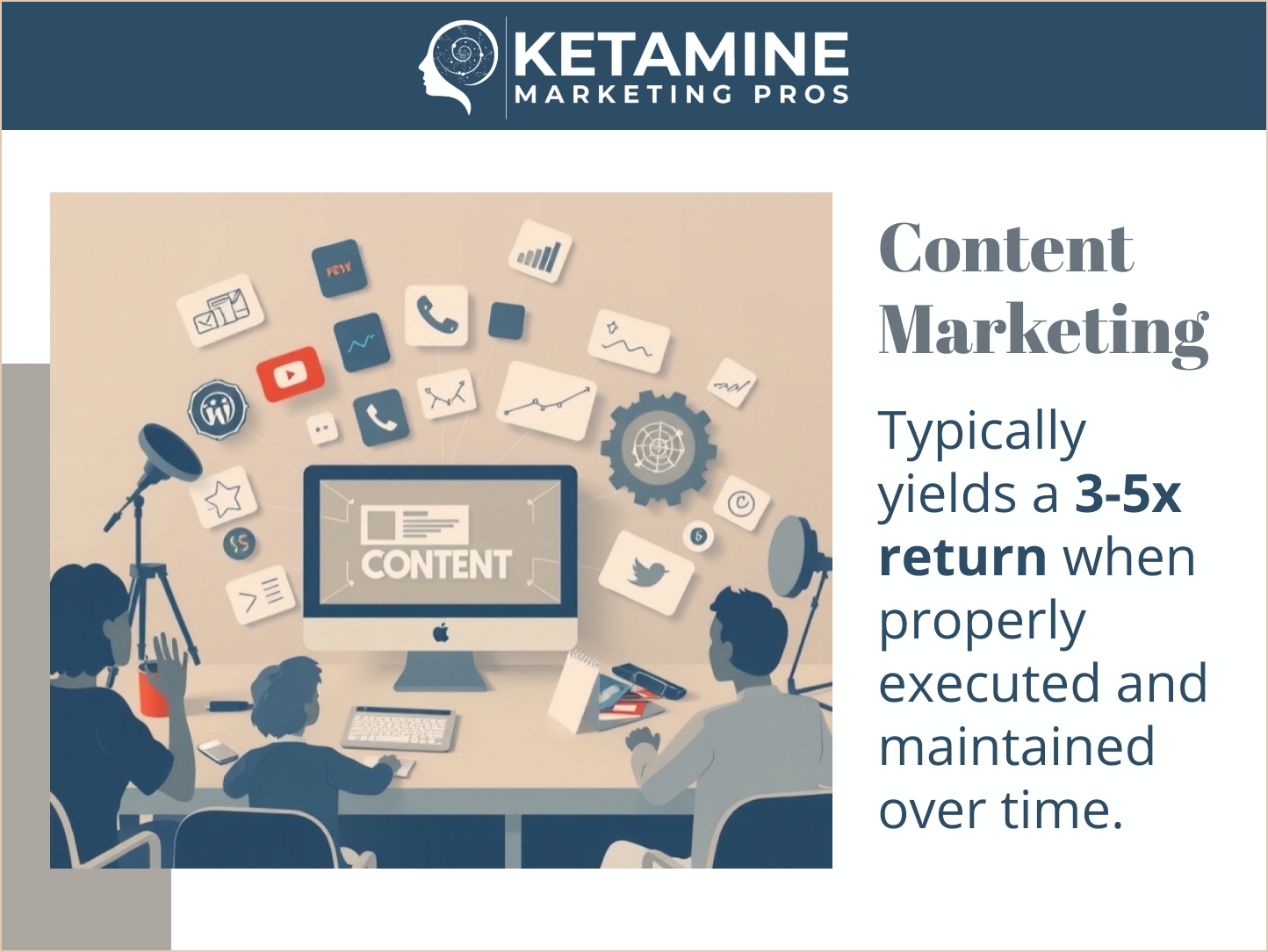
The evolution of content marketing has expanded far beyond traditional written formats, embracing a diverse range of multimedia approaches. Video content, in particular, has emerged as a dominant force in the digital landscape, with YouTube surpassing conventional entertainment channels including streaming services, podcast platforms, and traditional media outlets. This shift reflects changing consumer preferences and the increasing importance of visual storytelling in engaging and attracting ketamine therapy patients.
For ketamine therapy providers, this transformation in content marketing presents unprecedented opportunities to connect with and educate their target audience. Through thoughtful content strategy, these organizations can build trust through thought leadership, demonstrate their expertise across various formats, and establish authoritative positions in their specific medical niches. The combination of written and visual content creates a comprehensive digital presence that resonates with potential patients and referral sources alike.
Success in modern content marketing requires an integrated approach that leverages both written and visual formats across multiple platforms. By creating high-quality, consistent content that addresses audience needs and preferences, ketamine clinics can maximize their reach, deepen engagement, and ultimately achieve superior returns on their marketing investments. This strategic combination of content types and channels helps ketamine therapy clinics build lasting connections with their target audiences while establishing themselves as trusted leaders in the ketamine industry.
Mistake Number Two: Ignoring the Importance of SEO
When it comes to search, it’s Google’s world, and we’re just living in it.
According to a Pew Research study, 83% of adults research health information online before seeking treatment, while Google reports that 77% of patients use search engines before booking medical appointments. The consequences of a deficient ketamine therapy search engine marketing strategy are low online visibility and missed opportunities.
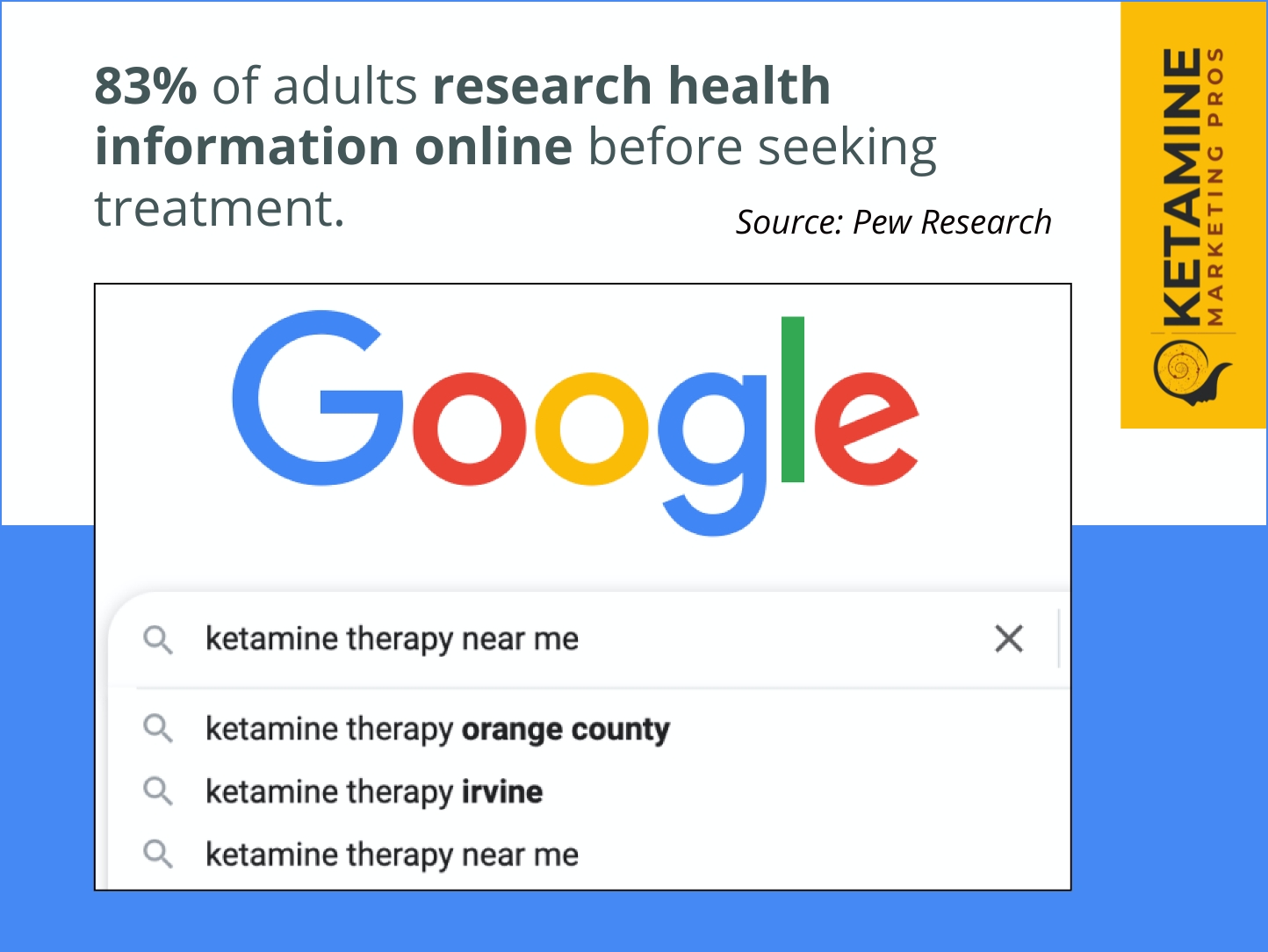
Investing in comprehensive local SEO strategies is crucial for ketamine clinics looking to enhance their online presence and attract potential patients. While Google Business Profile (GBP) optimization serves as a fundamental starting point, there are numerous other tactical approaches that can significantly boost local visibility.
Website Localization
Effective website localization requires a comprehensive approach to connecting with your local ketamine patient audience. Creating location-specific service pages serves as the foundation, incorporating local landmarks and geographic references to establish familiarity. It’s essential to embed Google Maps on your contact page for easy navigation and maintain NAP (Name, Address, Phone) consistency throughout your web pages. Optimizing meta titles and descriptions with location-specific keywords, along with creating neighborhood-specific content and guides, helps establish strong local relevance.
Technical SEO Elements
Technical optimization is vital for local search success. Implement local schema markup to help search engines better understand your location-specific content. Ensure your website is optimized for mobile devices and maintains fast loading speeds across all pages. Create location-specific URLs and utilize geotargeted meta tags to enhance local search visibility. These technical elements work together to improve your local search presence and user experience.
Local Link Building
As we’ve identified in a previous blog post, local link building not only establishes ketamine clinic brand recognition within your community, it serves as a powerful SEO strategy. Participating in community events and sponsoring local activities can generate backlinks to your ketamine therapy website. As can connecting with and sharing online referrals with local healthcare providers.
Directory Management
A robust directory management strategy is crucial for ketamine clinic local visibility. Your clinic should be listed in relevant medical and local business directories while maintaining consistent NAP information across all platforms. Focus particularly on healthcare-specific directories like Healthgrades and RateMDs. It’s important to claim and verify listings on major platforms such as Yelp and Yellow Pages. Regular monitoring and updating of directory information ensures continued accuracy and relevance.
Mistake Number Three: Underestimating the Power of Online Reviews
patient reviews have become a cornerstone of healthcare provider selection, particularly in the sensitive field of mental health treatment. The personal nature of mental health struggles makes patients especially receptive to others’ experiences and testimonials. This dynamic is reflected in compelling statistics: 77% of potential patients begin their healthcare journey by consulting online reviews, making them a crucial first touchpoint in the patient acquisition process.
The impact of online reviews on healthcare decisions is even more substantial, with an overwhelming 94% of patients use them to evaluate potential providers. Perhaps most significantly, nearly half of these individuals are willing to venture outside their insurance networks when they encounter providers with exceptional reviews. This behavior is particularly relevant for ketamine therapy clinics, where treatments typically aren’t covered by insurance, making positive patient testimonials a powerful tool for justifying out-of-pocket expenses.

Pair this with the imperative of local SEO, and it becomes the sweet spot where Google Business Profile (GBP) reviews become so important. GBP reviews serve a dual purpose: they not only influence Google’s search algorithm, potentially improving a clinic’s visibility in local search results, but they also directly impact potential patients’ decision-making processes. Positive reviews create a virtuous cycle – better visibility leads to more patient inquiries, which can result in more reviews, further enhancing the clinic’s online presence and credibility. This makes maintaining and managing a strong review profile not just beneficial, but essential for ketamine clinic growth and success.
Mistake Number Four: Reluctance to Adopt New Marketing Strategies
While we can extensively discuss proven digital marketing strategies, methodologies, and best practices, these insights hold value only when actively implemented. The success of ketamine clinics hinges on more than just clinical excellence. The harsh reality is that ketamine clinics refusing to embrace modern marketing approaches risk obsolescence in an increasingly competitive market.
The Consequences of Marketing Inertia
Ketamine clinics that maintain a passive stance toward digital marketing face significant challenges. As competitors adopt sophisticated online strategies, clinics clinging to traditional methods find themselves increasingly invisible to potential patients. This invisibility isn’t just about reduced online presence – it translates directly to declining patient acquisition, decreased revenue, and diminished market share. In an industry where patient education and trust-building primarily occur in digital spaces, marketing inertia can be fatal to practice growth.
The Competitive Imperative
The ketamine therapy market is experiencing unprecedented growth, with new clinics entering the space regularly and established mental health providers expanding their services to include ketamine treatments. This increasing competition makes digital marketing adoption not just advantageous but necessary for survival. Clinics must recognize that their competitors are likely already implementing comprehensive digital strategies, from content marketing to social media engagement and SEO optimization.
The Cost of Inaction
The consequences of failing to adapt to modern marketing requirements in ketamine therapy extend far beyond immediate financial implications. As the industry evolves and competition intensifies, clinics that resist embracing digital marketing strategies face multiple critical risks to their sustainability and growth. Without effective online presence and marketing strategies, practices struggle to scale their operations efficiently, while simultaneously losing market position to more proactive competitors who are actively engaging in digital spaces.
The ripple effects of marketing inaction create a compounding negative impact on practice success. Ketamine clinics miss valuable opportunities to connect with ideal patients who increasingly begin their healthcare journey online, while failing to build the crucial online authority necessary for establishing credibility. Perhaps most critically, ketamine therapy practices risk becoming irrelevant in patient search processes as potential clients increasingly rely on digital channels to research and select their healthcare providers.
Mistake Number Five: Over-Dependence on Traditional Referral Networks
Relying exclusively on conventional referral systems for ketamine therapy can significantly limit your ketamine clinic’s growth potential. Unlike traditional medical practices where word-of-mouth referrals often drive substantial patient flow, ketamine therapy faces unique challenges that demand a more sophisticated approach. Selecting ketamine therapy for mental health treatment possess more intricacies than merely choosing to use a dentist your white-toothed neighbor recommends.
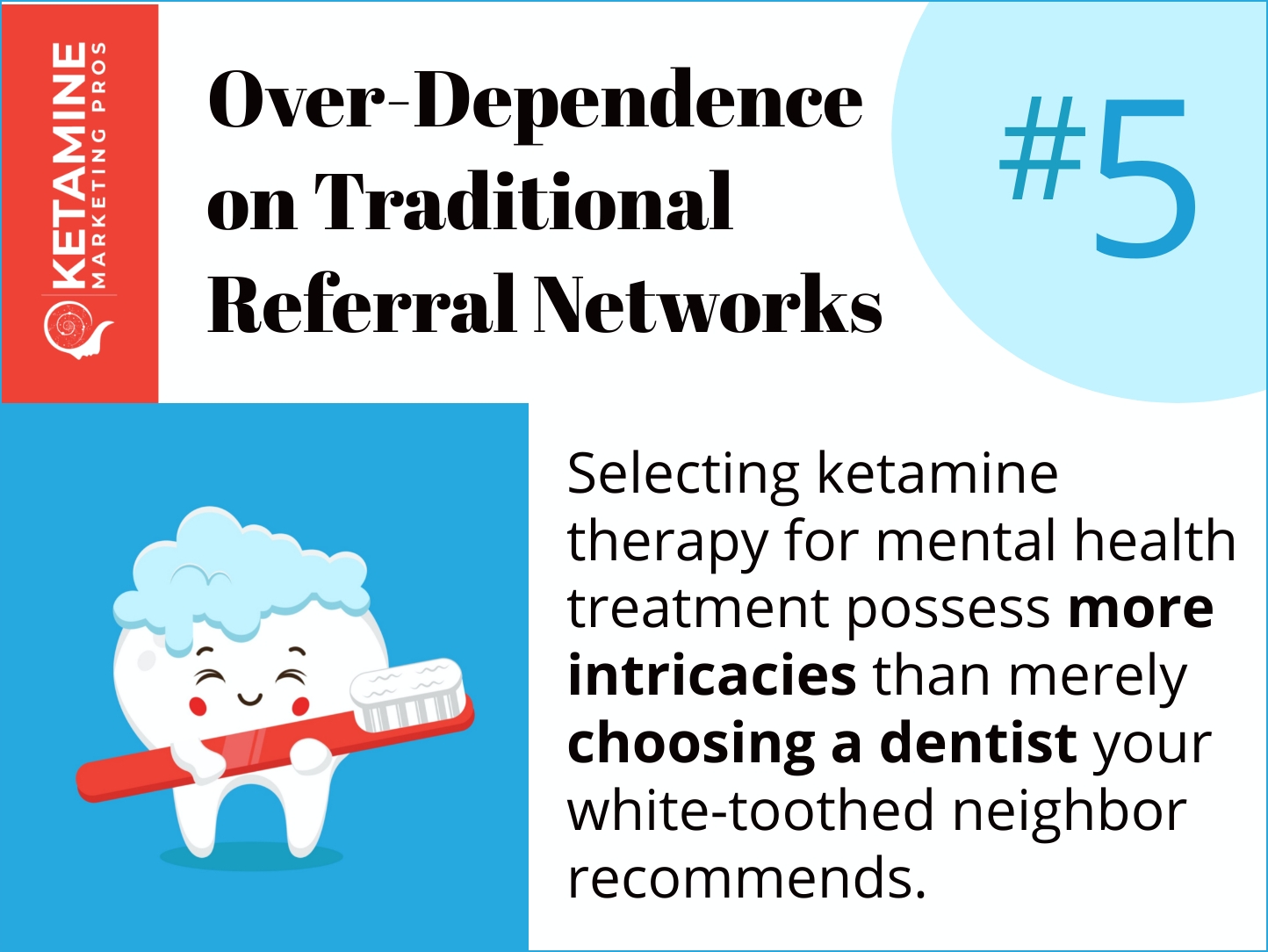
Why Traditional Referrals Alone Don’t Work
While referrals from satisfied patients and healthcare professionals remain valuable, they alone cannot sustain a thriving ketamine practice for several critical reasons.
Ketamine Therapy Awareness Challenges
The current state of public awareness presents a substantial barrier, with only 37% of Americans familiar with ketamine therapy as a treatment option. This limited awareness creates a narrow funnel for potential referrals, as people cannot recommend or seek out treatments they don’t know exist. Even among those aware of ketamine therapy, many lack understanding of its transformative potential in treating conditions like depression, PTSD, and chronic pain.
Professional Hesitation and Education Gaps
Within the medical community, several significant factors restrict the potential for ketamine therapy referrals. Many mental health professionals maintain a cautious stance toward ketamine therapy, despite mounting evidence supporting its efficacy. Traditional practitioners often express concerns about liability and risk management, while others simply lack a comprehensive understanding of ketamine’s therapeutic applications. This hesitation is further compounded by conservative treatment approaches that typically favor conventional methods over innovative solutions. Additionally, institutional policies in many healthcare settings may explicitly limit or discourage referrals to ketamine providers, creating another barrier to patient access.
Limitations of Trauma-Informed Care Network
The landscape of ketamine therapy referrals is further complicated by variations in treatment philosophies across the mental health sector. Not all mental health organizations have embraced trauma-informed care principles, and even those that do might harbor reservations about ketamine therapy. A persistent professional bias against psychedelic medicines continues to influence decision-making in many medical circles. The integration of ketamine therapy into traditional treatment protocols remains inconsistent, and the lack of standardized referral protocols for alternative treatments creates additional obstacles for patient access and provider collaboration.
Growth Constraints and Business Impact
Depending solely on referrals creates several critical business challenges for ketamine clinics. The most immediate impact is restricted patient flow due to limited referral sources, resulting in slower practice growth compared to clinics employing more proactive marketing approaches. These practices also face increased vulnerability to changes in referral patterns or professional relationships, which can create unstable patient acquisition cycles. Furthermore, relying exclusively on referrals often leads to missed opportunities to reach directly interested patients who might bypass traditional medical gatekeepers. This conventional approach also presents significant challenges in scaling the practice effectively, potentially limiting long-term growth and sustainability.
Moving Forward
The success of a ketamine clinic hinges largely on its ability to navigate the complex landscape of healthcare marketing while avoiding critical mistakes. These fundamental marketing errors can severely impact a clinic’s ability to attract and retain patients, potentially threatening its long-term viability. Understanding and actively preventing these essential marketing missteps is crucial for ketamine providers who aim to build and maintain a thriving practice. By recognizing and addressing these core marketing challenges early on, clinics can better position themselves for sustainable growth and success in the increasingly competitive ketamine therapy market.
Ready to Take Your Ketamine Clinic to the Next Level?
The future of mental health care is here—and ketamine therapy is leading the way. But to truly thrive, your clinic needs to be visible in your community, earn patient trust, and communicate its life-changing potential effectively. That’s what we’re here to help you accomplish.
Partnering with Ketamine Marketing Pros is more than just an investment in marketing; it’s an investment in your clinic’s growth, credibility, and ability to make a difference in patients’ lives. Let us help you attract more patients, increase your revenue, and position your clinic as a leader in the field of mental health and alternative therapies.
Contact Us Today for a FREE Marketing Consultation!




